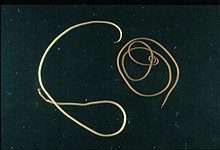Nematoida
| Nematoida Temporal range: Possible Ediacaran records[2]
| |
|---|---|

| |
| Paragordius tricuspidatus | |
| Scientific classification | |
| Domain: | Eukaryota |
| Kingdom: | Animalia |
| Subkingdom: | Eumetazoa |
| Clade: | ParaHoxozoa |
| Clade: | Bilateria |
| Clade: | Nephrozoa |
| (unranked): | Protostomia |
| Superphylum: | Ecdysozoa |
| Clade: | Nematoida Schmidt-Rhaesa, 1996 |
| Subdivisions | |
| Synonyms | |
| |
Nematoida is a clade of pseudocoelomate free living or parasitic animals. It consists of phyla Nematoda and Nematomorpha.[3][4] The two groups share a number of features in common; the presence of a cloaca in both sexes, aflagellate sperm, and a cuticle made of collagen.[4]
Its position within Ecdysozoa is uncontroversial, but the identity of their closest relatives has been debated. Under the Cycloneuralia hypothesis, the nematoids are considered to be closest to Scalidophora, named for the ring-shaped brains found in these animals.[5] However, this group has seen less support in phylogenetic analyses, with the Cryptovermes hypothesis being more consistently supported,[4][6][7] which groups the nematoids with the panarthropods, although the issue is still not completely settled.
References
[edit]- ^ Poinar, George (January 2008). "Palaeonema phyticum gen. n., sp. n. (Nematoda: Palaeonematidae fam. n.), a Devonian nematode associated with early land plants". Nematology. 10 (1): 9–14. doi:10.1163/156854108783360159.
- ^ Hughes, Ian V.; Evans, Scott D.; Droser, Mary L. (November 2024). "An Ediacaran bilaterian with an ecdysozoan affinity from South Australia". Current Biology. doi:10.1016/j.cub.2024.10.030.
- ^ "articulata". Archived from the original on 2010-05-10. Retrieved 2009-06-28.
- ^ a b c Telford, Maximillian; et al. (11 January 2008). "The evolution of the Ecdysozoa". Philosophical Transactions. 363 (1496): 1529–1537. doi:10.1098/rstb.2007.2243. PMC 2614232. PMID 18192181.
- ^ Hejnol, Andreas (2015). "Cycloneuralia". Evolutionary Developmental Biology of Invertebrates 3. pp. 1–13. doi:10.1007/978-3-7091-1865-8_1. ISBN 978-3-7091-1864-1.
- ^ Howard, Richard. "The Deep Evolution of Ecdysozoa". ProQuest. Archived from the original on 2023-07-18. Retrieved 2024-04-19.
- ^ Howard, Richard; et al. (10 March 2022). "The Ediacaran origin of Ecdysozoa: integrating fossil and phylogenomic data". Journal of the Geological Society. 179 (4). Bibcode:2022JGSoc.179..107H. doi:10.1144/jgs2021-107. hdl:2445/186596.
